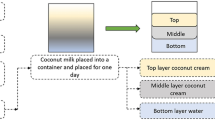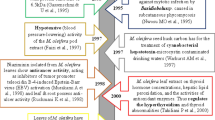Abstract
Flavored olive oils were generally produced with the maceration method, which has disadvantages such as taking a long time and making the tanks unusable for a long time. The new techniques could produce flavored oils to shorten time according to maceration. In this work, three different olive oil types, including extra-virgin olive oil (EVOO), refined olive oil (RO), and refined olive pomace oil (RPO) as oil sources and five plant materials (Tulsi, Thyme, Marjoram, Rosemary and Oregano) as flavoring materials were selected and subjected to a heating process in a microwave oven for a duration of 6, 8, 10, and 15 min at a constant frequency of 2450 MHz and a power of 0.45 kW to produce flavored oils and also used maceration technique. The presence of 4 PAH components, such as benzo(a)pyrene (B[a]P), benzo[a]anthracene (B[a]A), benzo(b)fluoranthene (B[b]F), and Chrysen (Chr), classified as dangerous for health was measured in the oils that were macerated and microwaved. In macerated oils, only B[a]P was detected in flavored RPOs. However, B[a]P and Chr were detected in all flavored oils, especially in a long-time microwave (10 and 15 min). Besides, B[a]A and B[b]F were found in only flavored RPOs with an increase in exposure time (10 and 15 min). The concentration of B[a]P detected in four samples, including the control sample (CRPO) and flavored samples, was above the limit value of 2 µg/kg. On the other hand, the total content of the four PAHs: B[a]P, B[a]A, B[b]F and Chr did not exceed the limit value of 10 μg/kg. As a result, PAHs are higher in extended exposure to microwave applications in flavored olive oils, compared to the conventional maceration method, resulting in lower-quality products regarding food safety.










Similar content being viewed by others
Data availability
Data are available from corresponding author upon request.
References
Abacıgil TÖ, Kıralan M, Ramadan MF (2023) Quality parameters of olive oils at different ripening periods as affected by olive fruit fly infestation and olive anthracnose. Rend Fis Acc Lincei 34:595–603. https://doi.org/10.1007/s12210-023-01157-1
An KJ, Liu YL, Liu HL (2017) Relationship between total polar components and polycyclic aromatic hydrocarbons in fried edible oil. Food Addit Contam Part A 34(9):1596–1605
Assami K, Chemat S, Meklati BY, Chemat F (2016) Ultrasound-assisted aromatisation with condiments as an enabling technique for olive oil flavouring and shelf life enhancement. Food Anal Methods 9:982–990
Ayadi MA, Grati-Kamoun N, Attia H (2009) Physico-chemical change and heat stability of extra virgin olive oils flavoured by selected Tunisian aromatic plants. Food Chem Toxicol 47(10):2613–2619
Belbahi A, Dairi S, Aoun O et al (2023) Ultrasound assisted maceration with Pistachia lentiscus (lentisk) leaves to enhance the antioxidant activity and the oxidative stability of extra virgin olive oil. Food Meas. https://doi.org/10.1007/s11694-023-01997-3
Benmoussa H, Elfalleh W, Farhat A, Servili M, Algabr M, Romdhane M (2016) Impact of microwave assisted infusion on the quality and volatile composition of olive oil aromatized with Rosemary leaves. J Am Oil Chem Soc 93:921–928
Bertoz V, Purcaro G, Conchione C, Moret S (2021) A review on the occurrence and analytical determination of PAHs in olive oils. Foods 10(2):324
Chéu-Guedes MH, La Rubia MD, Sánchez S, Ramos N, Pacheco R (2023) Characterization of flavoured olive oils of ‘madural’ variety. Processes 11(1):205
Ekner H, Dreij K, Sadiktsis I (2022) Determination of polycyclic aromatic hydrocarbons in commercial olive oils by HPLC/GC/MS-occurrence, composition and sources. Food Control 132:108528
Elaridi J, Fakhro M, Yamani O, Dimassi H, Othman H, Attieh Z (2020) GC-MS analysis of polycyclic aromatic hydrocarbons in bottled olive oil marketed in Lebanon. Toxicol Res 36:211–220
Frankel EN (2011) Nutritional and biological properties of extra virgin olive oil. J Agric Food Chem 59(3):785–792
Gavahian M, Khaneghah AM, Lorenzo JM, Munekata PE, Garcia-Mantrana I, Collado MC, Meléndez-Martínez AJ, Barba FJ (2019) Health benefits of olive oil and its components: impacts on gut microbiota antioxidant activities, and prevention of noncommunicable diseases. Trends Food Sci Technol 88:220–227
Kiralan SS, Tekin A (2020) Reducing polycyclic aromatic hydrocarbons (PAHs) in olive pomace oil using short-path molecular distillation. Food Addit Contam Part A 37(3):401–407
Lamas S, Rodrigues N, Peres AM, Pereira JA (2022) Flavoured and fortified olive oils-pros and cons. Trends Food Sci Technol 124:108–127
Llorent-Martínez EJ, Ortega-Barrales P, Fernández-de Córdova ML, Ruiz-Medina A (2011) Analysis of the legislated metals in different categories of olive and olive-pomace oils. Food Control 22(2):221–225
Moret S, Conte LS (2002) A rapid method for polycyclic aromatic hydrocarbon determination in vegetable oils. J Sep Sci 25(1–2):96–100
Patel AB, Shaikh S, Jain KR, Desai C, Madamwar D (2020) Polycyclic aromatic hydrocarbons: sources, toxicity, and remediation approaches. Front Microbiol 11:562813
Rodríguez-Acuña R, del Carmen Pérez-Camino M, Cert A, Moreda W (2008) Polycyclic aromatic hydrocarbons in Spanish olive oils: relationship between benzo (a) pyrene and total polycyclic aromatic hydrocarbon content. J Agric Food Chem 56(21):10428–10432
Sampaio GR, Guizellini GM, da Silva SA, de Almeida AP, Pinaffi-Langley ACC, Rogero MM, de Camargo AC, Torres EA (2021) Polycyclic aromatic hydrocarbons in foods: biological effects, legislation, occurrence, analytical methods, and strategies to reduce their formation. Int J Mol Sci 22(11):6010
Singh L, Varshney JG, Agarwal T (2016) Polycyclic aromatic hydrocarbons’ formation and occurrence in processed food. Food Chem 199:768–781
Sousa A, Casal S, Malheiro R, Lamas H, Bento A, Pereira JA (2015) Aromatized olive oils: influence of flavouring in quality, composition, stability, antioxidants, and antiradical potential. LWT-Food Sci Technol 60(1):22–28
Toptancı İ, Kıralan S, Ketenoğlu O (2023) A survey of phthalates in flavored olive oils from Turkey. Grasas Aceites 74(2):e502–e502
Trovato E, Russo M, Cucinotta L, Oulad El Majdoub Y, Testa Camillo MR, De Grazia G, Arigò A, Sciarrone D, Mondello L, Dugo P (2023) Quality evaluation of flavoured extra-virgin olive oils according to their chemical composition. Food Anal Methods 16:1313–1335
Zhu Y, Li X, Huang J, Zhao C, Qi J, Jin Q, Wang X (2018) Correlations between polycyclic aromatic hydrocarbons and polar components in edible oils during deep frying of peanuts. Food Control 87:109–116
Author information
Authors and Affiliations
Corresponding author
Ethics declarations
Conflict of interest
The authors have no competing interests to declare that are relevant to the content of this article.
Consent for publication
All authors consent for the manuscript to be published.
Additional information
Publisher's Note
Springer Nature remains neutral with regard to jurisdictional claims in published maps and institutional affiliations.
Supplementary Information
Below is the link to the electronic supplementary material.
Rights and permissions
Springer Nature or its licensor (e.g. a society or other partner) holds exclusive rights to this article under a publishing agreement with the author(s) or other rightsholder(s); author self-archiving of the accepted manuscript version of this article is solely governed by the terms of such publishing agreement and applicable law.
About this article
Cite this article
Kıralan, M., Çakıcı, H.F., Toptancı, İ. et al. Measurement of polycyclic aromatic hydrocarbons in aroma-flavored olive oils produced using microwave and traditional maceration methods. Rend. Fis. Acc. Lincei 34, 1185–1195 (2023). https://doi.org/10.1007/s12210-023-01191-z
Received:
Accepted:
Published:
Issue Date:
DOI: https://doi.org/10.1007/s12210-023-01191-z




